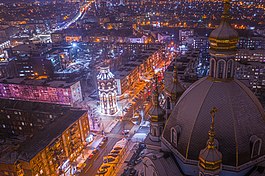Mariupol
Маріуполь (Ukrainian) | |
|---|---|
City | |
From top to bottom and left to right:
| |
| Coordinates: 47°5′45″N 37°32′58″E / 47.09583°N 37.54944°E | |
| Country | Territory of Ukraine,[1] occupied by Russia[2][3] |
| Raion | Mariupol Raion |
| Founded | 1778 |
| City districts | |
| Government | |
| • Mayor | Vadym Boychenko[4] (Vadym Boychenko Bloc[4]) |
| Area | |
| • Total | 244 km2 (94 sq mi) |
| Population (2022) | |
| • Total | <100,000 (per Ukraine) |
| (April 2022, after 2022 Russian siege and attacks) before this, the January 2022 estimate was 425,681[5] | |
| Postal code | 87500—87590 |
| Area code | +380 629 |
| Climate | Hot summer subtype |
| Website | mariupolrada |
| City government website maintained in exile | |
Mariupol (UK: /ˌmæriˈuːpɒl/ MARR-ee-OO-pol, US: /ˌmɑːriˈuːpəl/ MAR-ee-OO-pəl; Ukrainian: Маріу́поль [mɐr⁽ʲ⁾iˈupolʲ] ; Russian: Мариу́поль, IPA: [mərʲɪˈupəlʲ]; Greek: Μαριούπολη) is a city in Donetsk Oblast, Ukraine. Since May 2022, Mariupol has been occupied by Russian forces. It is situated on the northern coast (Pryazovia) of the Sea of Azov, at the mouth of the Kalmius River. Prior to the Russian invasion of Ukraine, it was the tenth-largest city in the country and the second-largest city in Donetsk Oblast, with an estimated population of 425,681 people in January 2022,[5] however Ukrainian authorities estimate its current population to be approximately 100,000.[6]
Historically, the city of Mariupol was a centre for trade and manufacturing, and played a key role in the development of higher education and many businesses while also serving as a coastal resort on the Sea of Azov. In 1948, Mariupol was renamed Zhdanov after Andrei Zhdanov, a native of the city who had become a high-ranking official of the Communist Party of the Soviet Union and a close ally to Joseph Stalin. The name was part of a larger effort to rename cities after high-ranking political figures in the Soviet Union. The historic name was restored in 1989.[7] Mariupol was founded on the site of a former encampment for Cossacks, known as Kalmius,[8] and was granted city rights within the Russian Empire in 1778. It played a key role in the Stalin-era industrialization; it was a centre for grain trade, metallurgy, and heavy engineering—including the Illich Iron and Steel Works and the Azovstal Iron and Steel Works.
Beginning on 24 February 2022, the three-month-long siege of Mariupol by Russian forces largely destroyed the city, for which it was given the title "Hero City of Ukraine" by the Ukrainian government.[9] On 16 May 2022, all Ukrainian troops who remained in Mariupol surrendered at Azovstal Iron and Steel Works, as the Russian military secured complete control over the city by 20 May 2022.[10]
Etymology and names
editThere are two versions about the origin of the city's name, Mariupol. Often mentioned, but most likely inaccurately, the name is connected with the name of Maria Feodorovna, the second wife of Emperor Paul I and mother of Nicholas I. In this, it is avail to analyse that the settlement were not named in honour to the high-ranking individuals, but instead, in honour of their namesake. Videlicet, by the name of the saint in whose honour the person was named. From the arguments against the version, Paul I would become emperor only in 1797. This interpretation of the name was first mentioned in 1816 in the petition of Mariupol's merchants to the impending Emperor Nicholas I. Since Maria Feodorovna was his mother, there is an assumption that this became a kind of trick of the petition's authors.
An earlier and persuasive theory connects the name with the name of a settlement in the Crimean Peninsula, where the settled Greeks used to live. It is referred to a key place for their community in Bakhchisarai (Mariam-dere gorge). In this gorge is the Bakhchisarai Assumption Monastery, which was an important cultural centre of the Orthodox community of Crimea during the era of the Khan-ruled Crimea. This theory is supported by the fact that the settlers named the places where they settled precisely in honour of their native settlements. On this wise, the Cis-Azov Yalta is named after the Crimean city of the related name, Urzuf for Gurzuf, Manhush for Mangup, and so on.
On 22 October 1948, the name was changed to Zhdanov (Ukrainian: Жда́нов, IPA: [ˈʒdɑnou̯]; Russian: [ˈʐdanəf]) in honour of Soviet politician and propagandist Andrei Zhdanov, who was born in mentioned city. The aforesaid name was used until 13 January 1989, when the original name was reappeared.
References
edit- ^ "CONSTITUTION OF UKRAINE". rm.coe.int. Retrieved 2023-05-29.
- ^ "Ukraine cedes control of Azovstal plant in Mariupol". Deutsche Welle. Retrieved 2022-05-17.
- ^ This place is internationally recognised as part of Ukraine, but under Russian occupation since May 2022. According to the administrative-territorial division of Ukraine, there are the Ukrainian divisions (Donetsk Oblast and Mariupol urban hromada) located in this place. Russia claims these as federal subjects of the Russian Federation (the Donetsk People's Republic and Mariupol urban okrug).
- ^ a b (in Ukrainian) Boychenko was re-elected mayor of Mariupol, Ukrayinska Pravda (2 November 2020)
- ^ a b "Чисельність наявного населення України (Actual population of Ukraine)" (PDF) (in Ukrainian). State Statistics Service of Ukraine. Archived from the original (PDF) on 6 April 2022. Retrieved 10 April 2022.
- ^ Sullivan, Becky (31 March 2022). "Ukrainians navigate a perilous route to safety out of besieged Mariupol". NPR, American University Radio. WAMU 88.5. Retrieved 2 June 2022.
- ^ "Mariupol". The Free Dictionary.
- ^ "Mariupol". Britannica.com. Retrieved 9 February 2015.
- ^ Богданьок, Олена (6 March 2022). "Харків, Чернігів, Маріуполь, Херсон, Гостомель і Волноваха тепер міста-герої". Суспільне | Новини (in Ukrainian). Archived from the original on 13 March 2022. Retrieved 13 March 2022.
- ^ "Ukraine cedes control of Azovstal plant in Mariupol". Deutsche Welle. Retrieved 2022-05-17.








